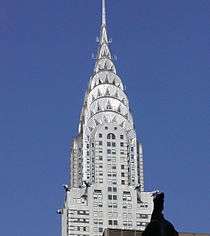Hudson Square
Coordinates: 40°43′36″N 74°00′22″W / 40.7268°N 74.0060°W

Hudson Square is a neighborhood in Lower Manhattan, New York City approximately bounded by West Houston Street to the north, Canal Street to the south, Sixth Avenue (Avenue of the Americas) to the east and the Hudson River to the west.[1] To the north of the neighborhood is Greenwich Village, to the south is TriBeCa, and to the east is SoHo. The area once was known as the Printing District, and into the 21st century it remains a center of media-related activity, including in advertising, design, communications, and the arts.[2]
Within the neighborhood is the landmarked Charlton-King-Vandam Historic District, which contains the largest concentration of Federalist and Greek Revival style row houses built during the first half of the 19th century. The most prominent feature within the neighborhood is the Manhattan entrance to the Holland Tunnel. The tallest structure in the neighborhood is the Trump SoHo hotel.
The Spring Street subway station (A C E trains) serves the neighborhood, as do several bus lines.
History
When George Washington led the defense of New York against the British in 1776, his headquarters were located at the Mortier House at what is now Charlton and Varick Streets. One of the earliest known uses of the term "New Yorker" in a published work is found in a letter that he wrote from Lower Manhattan.[3]
The neighborhood was home to the first African-American newspaper in the United States, called Freedom's Journal, edited by John Russwurm and Samuel Cornish from March 16, 1827 to March 28, 1829. The newspaper provided international, national, and regional information on current events and contained editorials declaiming against slavery, lynching, and other injustices.[4]
Trinity Wall Street owns substantial commercial real estate in Hudson Square.[5]
Points of interest

- The Ear Inn[6] is one of the oldest bars in New York City, said to have been established in 1817, built by George Washington’s aide. During Prohibition it was a speakeasy, but afterwards it had no name. It was known as "The Green Door" to sailors and longshoremen. In 1977, new resident-owners christened it the Ear Inn, a name chosen to avoid the New York City Landmarks Preservation Commission's lengthy review of any new sign. The neon "BAR" sign was painted to read EAR, after Ear Magazine, which was published upstairs.[7]
- The Holland Tunnel was once the longest underwater tunnel in the world. It officially opened at midnight on November 13, 1927.[8] It still serves as a heavily used Hudson River crossing, especially for trucks bound for Long Island.
- The New York City Fire Museum is located on 278 Spring Street between Hudson and Varick Streets.
- The Paradise Garage was a discotheque notable in the history of modern dance and pop music, as well as LGBT and nightclub cultures located at 84 King Street.[9][10]
- The SoHo Playhouse[11] stands on land that was once Richmond Hill, a colonial mansion that served as headquarters for General George Washington and later home to Aaron Burr. Purchased from Burr in 1817, the land was then developed into federalist-style row houses by fur magnate John Jacob Astor. 15 Van Dam Street was designated at the Huron Club, a popular meeting house and night club for the Democratic Party. The turn of the century brought the Tammany Hall machine to the Huron Club. Prominent regulars included "Battery" Dan Finn and the infamous Mayor Jimmy "Beau James" Walker. The main floor was transformed into a theater in the 1920s, and in the 1960s operated as the Village South, home to Playwrights Unit Workshop under the direction of Edward Albee. The playhouse now serves as a 199-seat off-Broadway venue.
- Steinway & Sons was founded in 1853 by German immigrant Henry Engelhard Steinway in a Manhattan loft on Varick Street.[12]
See also
References
- ↑ Mooney, Jake (August 20, 2010). "Living in Hudson Square". The New York Times. Retrieved 2014-12-30.
- ↑ "Extra! Extra! Media firms move to Hudson Square". The Villager. October 3, 2007. Retrieved 2010-07-31.
- ↑ "New York Times Correction". Retrieved 2014-01-07.
- ↑ Bacon, Jacqueline (2007). Freedom's Journal: The First African-American Newspaper. Lanham, MD: Lexington Books. p. 37. ISBN 978-0-7391-1893-1. Retrieved 2010-07-31.
- ↑ Sharon Otterman (April 24, 2013). "Trinity Church Split on How to Manage $2 Billion Legacy of a Queen". The New York Times. Retrieved April 25, 2013.
- ↑ "About Ear Inn". The Ear Inn. Retrieved 2010-07-31.
- ↑ Amateau, Albert (August 27, 2003). "Ear Inn has colorful history and uncertain future". The Villager. Retrieved 2010-07-31.
- ↑ "Did You Know - Holland Tunnel". Lower Manhattan Construction Command Center. Retrieved 2010-07-31.
- ↑ Violette, Richard (2000) Library Journal Review of My Life and The Paradise Garage: Cheren, Mel et al. (2000). My Life and The Paradise Garage: Keep On Dancin' . Hardcover: ISBN 0-9678994-0-0. Retrieved January 21, 2008.
- ↑ Pareles, Jon (June 18, 2000). "Paradise Garage, a Gay Club That Forever Changed Night Life", The New York Times. Retrieved January 21, 2008.
- ↑ "Mainstage". SoHo Playhouse. Retrieved 2010-07-31.
- ↑ "Steinway History". Steinway & Sons. Retrieved 2010-07-31.
External links
 Media related to Hudson Square at Wikimedia Commons
Media related to Hudson Square at Wikimedia Commons
